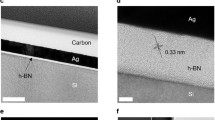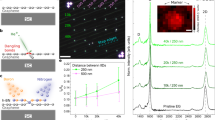Abstract
One-dimensional (1D) catalytic etching was investigated in few-layer hexagonal boron nitride (hBN) films. Etching of hBN was shown to share a number of similarities with that of graphitic films. As in graphitic films, etch tracks in hBN commenced at film edges and occurred predominantly along certain crystal directions of its lattice, though it was shown that the tracks were generally narrower than those of few-layer graphene under similar processing conditions. It was also shown that catalytic hydrogenation can occur completely through a few-layer hBN film, demonstrating that this process can be used in the formation of isolated low-dimensional nanoscale structures from other layered 2D materials beyond graphene. This ability for thin hBN films to be etched completely through allowed for a crystalline substrate to guide the etching process, which was demonstrated with the successful etch track formation of few-layer hBN on single-crystalline sapphire substrates. The substrate-guided etching resulted in parallel few-layer hBN nanoribbons having an average width of 32 nm and spacing of 13 nm.

Similar content being viewed by others
References
Elliot, S. The Physics and Chemistry of Solids; John Wiley & Sons: West Sussex, England, 1998.
Yu, L.; Riddle, A. J.; Wang, S. S.; Sundararajan, A.; Thompson, J.; Chang, Y. J.; Park, M. E.; Seo, S. S. A.; Guiton, B. S. Solid-liquid-vapor synthesis of negative metal oxide nanowire arrays. Chem. Mater. 2016, 28, 8924–8929.
Tomita, A.; Tamai, Y. Optical microscopic study on the catalytic hydrogenation of graphite. J. Phys. Chem. 1974, 78, 2254–2258.
Datta, S. S.; Strachan, D. R.; Khamis, S. M.; Johnson, A. T. C. Crystallographic etching of few-layer graphene. Nano Lett. 2008, 8, 1912–1915.
Avouris, P.; Chen, Z. H.; Perebeinos, V. Carbon-based electronics. Nat. Nanotechnol. 2007, 2, 605–615.
Geim, A. K.; MacDonald, A. H. Graphene: Exploring carbon flatland. Phys. Today 2007, 60, 35.
Nakada, K.; Fujita, M.; Dresselhaus, G.; Dresselhaus, M. S. Edge state in graphene ribbons: Nanometer size effect and edge shape dependence. Phys. Rev. B 1996, 54, 17954–17961.
Ci, L. J.; Xu, Z. P.; Wang, L. L.; Gao, W.; Ding, F.; Kelly, K. F.; Yakobson, B. I.; Ajayan, P. M. Controlled nanocutting of graphene. Nano Res. 2008, 1, 116–122.
Campos, L. C.; Manfrinato, V. R.; Sanchez-Yamagishi, J. D.; Kong, J.; Jarillo-Herrero, P. Anisotropic etching and nanoribbon formation in single-layer graphene. Nano Lett. 2009, 9, 2600–2604.
Hunley, D. P.; Sundararajan, A.; Boland, M. J.; Strachan, D. R. Electrostatic force microscopy and electrical isolation of etched few-layer graphene nano-domains. Appl. Phys. Lett. 2014, 105, 243109.
Hunley, D. P.; Boland, M. J.; Strachan, D. R. Integrated nanotubes, etch tracks, and nanoribbons in crystallographic alignment to a graphene lattice. Adv. Mater. 2015, 27, 813–818.
Wang, L. F.; Wu, B.; Jiang, L. L.; Chen, J. S.; Li, Y. T.; Guo, W.; Hu, P. G.; Liu, Y. Q. Growth and etching of monolayer hexagonal boron nitride. Adv. Mater. 2015, 27, 4858–4864.
Liao, Y. L.; Tu, K. X.; Han, X. G.; Hu, L. B.; Connell, J. W.; Chen, Z. F.; Lin, Y. Oxidative etching of hexagonal boron nitride toward nanosheets with defined edges and holes. Sci. Rep. 2015, 5, 14510.
Kim, D. H.; Lee, M.; Ye, B.; Jang, H. K.; Kim, G. T.; Lee, D. J.; Kim, E. S.; Kim, H. D. Catalytically-etched hexagonal boron nitride flakes and their surface activity. Appl. Surf. Sci. 2017, 402, 254–260.
Sutter, P.; Lahiri, J.; Albrecht, P.; Sutter, E. Chemical vapor deposition and etching of high-quality monolayer hexagonal boron nitride films. ACS Nano 2011, 5, 7303–7309.
Li, L. H.; Cervenka, J.; Watanabe, K.; Taniguchi, T.; Chen, Y. Strong oxidation resistance of atomically thin boron nitride nanosheets. ACS Nano 2014, 8, 1457–1462.
Yamamoto, M.; Einstein, T. L.; Fuhrer, M. S.; Cullen, W. G. Anisotropic etching of atomically thin MoS2. J. Phys. Chem. C 2013, 117, 25643–25649.
Ionescu, R.; George, A.; Ruiz, I.; Favors, Z.; Mutlu, Z.; Liu, C.; Ahmed, K.; Wu, R.; Jeong, J. S.; Zavala, L. et al. Oxygen etching of thick MoS2 films. Chem. Commun. 2014, 50, 11226–11229.
Zhou, H. Q.; Yu, F.; Liu, Y. Y.; Zou, X. L.; Cong, C. X.; Qiu, C. Y.; Yu, T.; Yan, Z.; Shen, X. N.; Sun, L. F. et al. Thickness-dependent patterning of MoS2 sheets with well-oriented triangular pits by heating in air. Nano Res. 2013, 6, 703–711.
Frindt, R. F.; Yoffe, A. D. Physical properties of layer structures: Optical properties and photoconductivity of thin crystals of molybdenum disulphide. Proc. Roy. Soc. A: Math. Phys. Eng. Sci. 1963, 273, 69–83.
Bhimanapati, G. R.; Lin, Z.; Meunier, V.; Jung, Y.; Cha, J.; Das, S.; Xiao, D.; Son, Y.; Strano, M. S.; Cooper, V. R. et al. Recent advances in two-dimensional materials beyond graphene. ACS Nano 2015, 9, 11509–11539.
Yin, J.; Li, J. D.; Hang, Y.; Yu, J.; Tai, G. A.; Li, X. M.; Zhang, Z. H.; Guo, W. L. Boron nitride nanostructures: Fabrication, functionalization and applications. Small 2016, 12, 2942–2968.
Chen, L. X.; He, L.; Wang, H. S.; Wang, H. M.; Tang, S. J.; Cong, C. X.; Xie, H.; Li, L.; Xia, H.; Li, T. X. et al. Oriented graphene nanoribbons embedded in hexagonal boron nitride trenches. Nat. Commun. 2017, 8, 14703.
Ma, L.; Zeng, X. C. Catalytic directional cutting of hexagonal boron nitride: The roles of interface and etching agents. Nano Lett. 2017, 17, 3208–3214.
Dean, C. R.; Young, A. F.; Meric, I.; Lee, C.; Wang, L.; Sorgenfrei, S.; Watanabe, K.; Taniguchi, T.; Kim, P.; Shepard, K. L. et al. Boron nitride substrates for high-quality graphene electronics. Nat. Nanotechnol. 2010, 5, 722–726.
Park, C. H.; Louie, S. G. Energy gaps and stark effect in boron nitride nanoribbons. Nano Lett. 2008, 8, 2200–2203.
Barone, V.; Peralta, J. E. Magnetic boron nitride nanoribbons with tunable electronic properties. Nano Lett. 2008, 8, 2210–2214.
Kan, E. J.; Wu, X. J.; Li, Z. Y.; Zeng, X. C.; Yang, J. L.; Hou, J. G. Half-metallicity in hybrid BCN nanoribbons. J. Chem. Phys. 2008, 129, 084712.
Lopez-Bezanilla, A.; Huang, J. S.; Terrones, H.; Sumpter, B. G. Boron nitride nanoribbons become metallic. Nano Lett. 2011, 11, 3267–3273.
Yoshimoto, M.; Maeda, T.; Ohnishi, T.; Koinuma, H.; Ishiyama, O.; Shinohara, M.; Kubo, M.; Miura, R.; Miyamoto, A. Atomic-scale formation of ultrasmooth surfaces on sapphire substrates for high-quality thin-film fabrication. Appl. Phys. Lett. 1995, 67, 2615–2617.
Hod, O. Graphite and hexagonal boron-nitride have the same interlayer distance. Why? J. Chem. Theory Comput. 2012, 8, 1360–1369.
Luo, Z. T.; Somers, L. A.; Dan, Y. P.; Ly, T.; Kybert, N. J.; Mele, E. J.; Johnson, A. T. C. Size-selective nanoparticle growth on few-layer graphene films. Nano Lett. 2010, 10, 777–781.
Qiu, Z. Y.; Song, L.; Zhao, J.; Li, Z. Y.; Yang, J. L. The nanoparticle size effect in graphene cutting: A “Pac-Man” mechanism. Angew. Chem., Int. Ed. 2016, 55, 9918–9921.
Tsukamoto, T.; Ogino, T. Control of graphene etching by atomic structures of the supporting substrate surfaces. J. Phys. Chem. C 2011, 115, 8580–8585.
Tsukamoto, T.; Ogino, T. Graphene etching controlled by atomic structures on the substrate surface. Carbon 2012, 50, 674–679.
Solís-Fernández, P.; Yoshida, K.; Ogawa, Y.; Tsuji, M.; Ago, H. Dense arrays of highly aligned graphene nanoribbons produced by substrate-controlled metal-assisted etching of graphene. Adv. Mater. 2013, 25, 6562–6568.
Iida, Y.; Yamazaki, K.; Ogino, T. Graphene nano-cutting using biologically derived metal nanoparticles. Carbon 2013, 63, 133–139.
Ago, H.; Kayo, Y.; Solís-Fernández, P.; Yoshida, K.; Tsuji, M. Synthesis of high-density arrays of graphene nanoribbons by anisotropic metal-assisted etching. Carbon 2014, 78, 339–346.
Middleman, S. The role of gas-phase reactions in boron nitride growth by chemical vapor deposition. Mater. Sci. Eng. A 1993, 163, 135–140.
Adams, A. C. Characterization of films formed by pyrolysis of borazine. J. Electrochem. Soc. 1981, 128, 1378–1379.
Shi, Y. M.; Hamsen, C.; Jia, X. T.; Kim, K. K.; Reina, A.; Hofmann, M.; Hsu, A. L.; Zhang, K.; Li, H. N.; Juang, Z. Y. et al. Synthesis of few-layer hexagonal boron nitride thin film by chemical vapor deposition. Nano Lett. 2010, 10, 4134–4139.
Mallard, G.; Linstrom, P. J. NIST Chemistry WebBook, NIST Standard Reference Database Number 69; National Institute of Standards and Technology: Gaithersburg, MD, 1998.
Atkins, P.; de Paula, J. Physical Chemistry: Thermodynamics, Structure, and Change, 10th ed.; W. H. Freeman and Company: New York, NY, 2014.
Nasseri, M.; Hunley, D. P.; Sundararajan, A.; Boland, M. J.; Strachan, D. R. Tuning between crystallographically aligned carbon nanotube growth and graphene etching. Carbon 2014, 77, 958–963.
Acknowledgements
The portion of the reported work on the few-layer graphene/hBN heterostructures was supported by the Department of Energy (DOE) Condensed Matter Physics (CMP) and EPSCoR programs through grant No. 0000223282, with additional coordinated funds from the Kentucky EPSCoR Program through the Kentucky Science and Technology Corporation (KSTC). The portion of the reported work on the etching of few-layer films on r-plane sapphire substrates was supported by the National Science Foundation (NSF) Chemical, Bioengineering, Environmental, and Transport Systems (CBET) program through grant No. 1603152.
Author information
Authors and Affiliations
Corresponding author
Electronic supplementary material
Rights and permissions
About this article
Cite this article
Ansary, A., Nasseri, M., Boland, M.J. et al. Parallel boron nitride nanoribbons and etch tracks formed through catalytic etching. Nano Res. 11, 4874–4882 (2018). https://doi.org/10.1007/s12274-018-2076-y
Received:
Revised:
Accepted:
Published:
Issue Date:
DOI: https://doi.org/10.1007/s12274-018-2076-y




